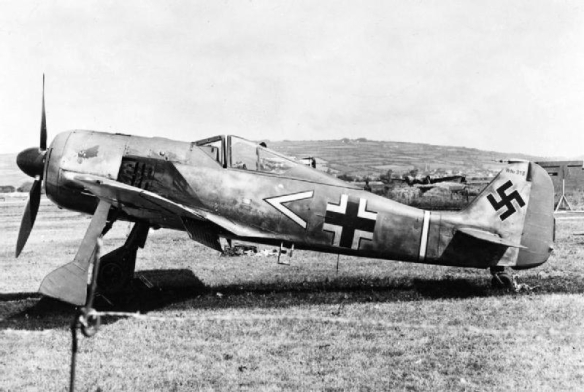
Armin Faber’s Focke-Wulf Fw 190A-3 of III/JG 2 at RAF Pembrey, June 1942.
In June 1942, Oberstleutnant Armin Faber was Gruppen-Adjutant to the commander of the III fighter Gruppe of Jagdgeschwader 2 (JG 2) based in Morlaix in Brittany. On 23 June, he was given special permission to fly a combat mission with 7th Staffel. The unit operated Focke-Wulf 190 fighters.
The FW-190 had only recently arrived with front line units at this time and its superior performance had caused the Allies so many problems that they were considering mounting a commando raid on a French airfield to capture one for evaluation.
7th Staffel was scrambled to intercept a force of six Bostons on their way back from a bombing mission; the Bostons were escorted by three Czechoslovak-manned RAF squadrons, 310 Squadron, 312 Squadron and 313 Squadron commanded by Alois Vašátko. A fight developed over the English Channel with the escorting Spitfires, during which Faber was attacked by Sergeant František Trejtnar (Czech) of 310 Squadron. In his efforts to shake off the Spitfire, Faber flew north over Exeter in Devon. After much high-speed manoeuvring, Faber, with only one cannon working, pulled an Immelmann turn into the sun and shot down his pursuer in a head-on attack.
Trejnar bailed out safely, although he had a shrapnel wound in his arm and sustained a broken leg on landing; his Spitfire crashed near the village of Black Dog, Devon. Meanwhile, the disorientated Faber now mistook the Bristol Channel for the English Channel and flew north instead of south. Thinking South Wales was France, he turned towards the nearest airfield – RAF Pembrey. Observers on the ground could not believe their eyes as Faber waggled his wings in a victory celebration, lowered the Focke-Wulf’s undercarriage and landed.
The Pembrey Duty Pilot, one Sergeant Jeffreys, grabbed a Very pistol and ran from the control tower and jumped onto the wing of Faber’s aircraft as it taxied in. Faber was apprehended and later taken to RAF Fairwood Common by Group Captain David Atcherley (twin brother of Richard Atcherley) for interrogation.
#
By the spring of 1942 the Fw 190 had become an uncomfortably sharp thorn in the side of RAF Fighter Command. Obviously, if an airworthy example of the Fw 190 could be captured and its secrets probed, that would be of inestimable value. Capt. Philip Pinckney, a British commando officer, hatched a daring plan to gain that end.
In an operation of this type, two men might succeed where more might fail. Pinckney suggested that his good friend Jeffrey Quill, chief test pilot at the Supermarine Company, should accompany him on the enterprise.
The essentials of the plan were as follows. On Night 1 a Royal Navy motor gunboat, equipped with direction-finding radio, was to carry the pair to a point within about two miles of a selected beach on the French coast, where they would disembark into a folding canoe. The pair would paddle ashore, hide their boat in sand dunes and lie up during the following day. On Night 2 the pair would move inland to within observation range of the selected Fw 190 airfield, and hide up before dawn. During the daylight hours the pair would keep the airfield under observation and plan their attack. On Night 3 the pair would penetrate the airfield defences by stealth, and conceal themselves as near as possible to one or more Fw 190s at their dispersal points. The pair would then wait until the next day, when the ground crew arrived to run the engine of one of the fighters.
The pair would then break cover, shoot or drive away the ground crewmen, and Jeffrey Quill would jump into the cockpit and taxi the machine to the runway. As he did so, Pinckney would be outside the plane warding off any attempt to interfere with the operation. Once Quill was safely airborne, Pinckney would withdraw to a previously prepared hide. On Night 4 he would return to the hidden canoe. Just before dawn he would launch the craft and paddle out to sea, making radio transmissions so that the motor gunboat could home on the craft and pick him up.
Yet in a remarkable coincidence, on the very day Pinckney submitted his proposal, the need for this risky operation disappeared. On the afternoon of 23 June an Fw 190 pilot had become disorientated in a dogfight with Spitfires over southern England. He mistook the Bristol Channel for the English Channel and made a wheels-down landing at Pembrey airfield, south Wales [above]. Thus, the RAF gained the coveted example of an Fw 190, without having to resort to the risky ‘Airthief operation.